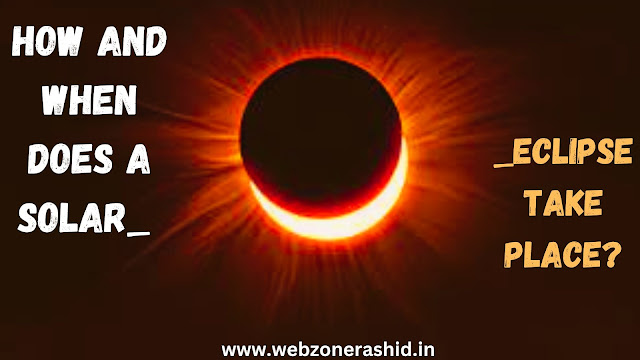Solar eclipses are a unique natural occurrence that have been occurring for ages. However, concerns about the solar eclipse's timing and mechanism will always be there in people's minds. If you are wondering the same things, this post will be especially helpful to you. Because we will provide you with comprehensive information on the solar eclipse in today's article.
You'll find answers to topics like what an eclipse is, why they happen, when they happen, and what kinds of eclipses are out there in this page. Any time the Moon passes in front of the Sun, a solar eclipse takes place. The sun appears black in this scenario, either whole or in part. What causes this to occur? Now that we have all the details, let's.
What is a solar eclipse, and why do they occur?
As we all know, the Moon orbits the Earth while the Earth revolves around the Sun. When the Moon is between the Sun and the Earth, a solar eclipse happens. We refer to this as a solar eclipse when the Earth, Moon, and Sun are all in the same line and the Sun looks partially or completely obscured when viewed from Earth. This occurs because the Moon is directly in front of the Sun, blocking parts of the Earth's surface from sunlight.
What causes a solar eclipse?
Solar eclipses always coincide with the Amavasya new moon. This is due to the Moon's proximity to the Earth's orbital plane at this time. But hardly every new moon day sees this incident. Why so? Let's examine this.
Every new moon would experience a solar eclipse if the Moon were in an orbit that was both perfectly circular and in the same plane as the Earth's orbit. As a result of the Moon's orbit being inclined to Earth's orbit by around 5 degrees, Earth typically misses the Moon's shadow.
Since lunar and solar eclipses only happen during the eclipse period (the 35-day period when the Moon is closest to the Earth's orbital plane), there are at least two and up to five solar eclipses per year, including Just two total solar eclipses occur every century.
Total solar eclipses are extremely uncommon because they call for a more exact alignment between the Sun's and the Moon's centres, and because the Moon's apparent size in the sky is so small as to totally engulf the Sun. There are 360–410 years on average between total solar eclipses visible from a particular location on earth.
Categories of solar eclipses (type)
There are four Categories of solar eclipses:
- Total solar eclipse
- Partial solar eclipse
- Annular solar eclipse
- Hybrid solar eclipse
Total Solar Eclipse: During a total solar eclipse, the Sun's light is entirely blocked by the moon's shadow, leaving only the solar corona's outermost layer visible. Only those who are in the path of the Moon's total shadow (umbra) can see a total solar eclipse. Only a partial solar eclipse is observable outside this path.
Partial Solar Eclipse: During this eclipse, only a portion of the Sun is visible as being covered since the Sun and the Moon are not exactly in line with the Earth. Large portions of the earth's surface outside of the umbra or where the moon's entire shadow does not fall typically have a good view of this event. However, because the deep shadow umbra is outside of the polar zone of the Earth, some eclipses are only visible as partial eclipses.
Annular solar Eclipse: The Moon will pass between the Sun and the Earth during an annular solar eclipse, but it will do so when it is either at or very near its farthest point from the Earth. The Moon can't totally block out the Sun since it is farther from Earth and hence appears smaller than the Sun. The Moon therefore appears to be surrounded by a ring and appears smaller than the Sun, which is itself a larger and brighter disc.
Hybrid Solar Eclipse: The curved surface of the Earth can occasionally cause a transition between a total solar eclipse and an annular eclipse. Both a total eclipse and an annular eclipse are seen at various locations on the earth's surface. However, it is uncommon to see such eclipses.
Both an umbra and a penumbra
Umbra: The umbra is the centre of the Moon's shadow, where the Sun appears to be completely obscured.
Penumbra: The outermost region of the Moon's shadow, when just a portion of the Sun's rays are blocked, is known as the penumbra.
Why can't the solar eclipse be observed (seen) directly?
Scientists advise against using bare eyes to see the solar eclipse. Someone who performs this could have issues like eclipse blindness or retinal burn. In the event of a solar eclipse, the sun's rays are more dangerous. The retina in your eyes, which has a direct connection to your brain, is susceptible to harm from these rays.
It takes some time to notice this eye issue. After a few hours or days, it is found. Your eyes' light can last forever as a result. To view the solar eclipse, it is advisable to wear eclipse glasses.
How long will there be a solar eclipse?
While a partial solar eclipse might persist for several hours, a total eclipse only lasts for 7 minutes and 32 seconds.
Conclusion(निष्कर्ष)
I believe you have a clear understanding of the solar eclipse's timing and mechanics. I've done my best to give you all the details on the solar eclipse so you won't have to look up more information on other websites. Please share this article on other social media platforms if you enjoyed it or learned something new from it.

